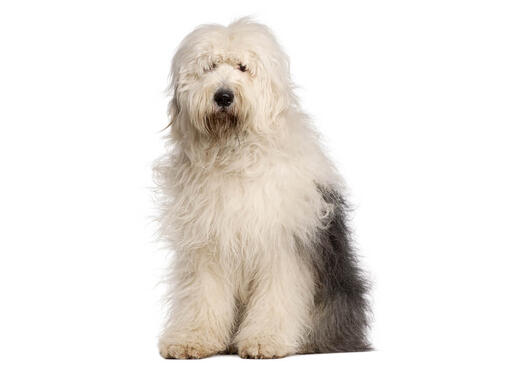
Old English Sheepdog
First developed in western England, the Old English Sheepdog originated about 150 years ago. A loving house dog, the Old English Sheepdog is intelligent, even-tempered and equally at home in an apartment or large house. An athletic dog with clownish energy, he requires regular exercise or a job. His beautiful, profuse coat requires regular grooming.
DID YOU KNOW? Prince Eric’s companion, “Max,” in Disney’s “The Little Mermaid” is an Old English Sheepdog. Old English Sheepdogs have been featured in several Jim Hensen creations, including the popular television show for preschoolers “Sesame Street,” the 1986 fantasy film “Labyrinth,” and the television series “Fraggle Rock.” President Franklin Delano Roosevelt owned an Old English Sheepdog named “Tiny.”
ALSO KNOWN AS: Shepherds Dog, Bob-tailed Sheepdog
The need-to-know
- Dog suitable for experienced owners
- Some training required
- Enjoys active walks
- Enjoys walking one to two hours a day
- Large dog
- Some drool
- Requires grooming daily
- Non hypoallergenic breed
- Chatty and vocal dog
- Guard dog. Barks and alerts
- May require training to live with other pets
- May require training to live with kids
Personality

Old English Sheepdogs are cheerful extroverts and are popular family companions. They are known for being intelligent, loving, watchful, faithful and protective. They are fearless and make excellent watch dogs, especially with their resonant bark. They can be overly boisterous however and need plenty of exercise, training and grooming.
History and Origins

Country of Origin: England
Despite their name, the Old English Sheepdog isn’t that old and wasn’t historically a sheepdog! They were mostly used as drover’s dogs, employed to help move cattle and any work they did with the sheep was purely part time.They were created in the late 18th century by crossing existing drover’s dogs with the Bearded Collie and possibly also some of the European breeds such as the Bergamasco. They were often known as Bobtails because they were traditionally docked as a tax avoidance scheme. Working drover’s dogs were exempt from taxes and so they were marked and ‘disabled’ in this way - whereas true sheepdogs needed their long tails to help with their complex and athletic sideways movements.
Nutrition and Feeding

Large breed dogs, as well as having large appetites, benefit from a different balance of nutrients including minerals and vitamins compared to smaller-breed dogs. The Old English Sheepdog breed is prone to bloating and stomach problems; smaller, more frequent meals can help minimise this risk.
Exercise

Old English Sheepdogs need owners who are dedicated to giving them a lot of exercise and also an outlet for their need to play and be a part of everything. They need around two hours exercise every day come rain or shine (which given their huge coats isn’t as easy as it sounds) and plenty of enrichment and interactive toys.
Other Information

Health and common issues
As with many breeds, the Old English Sheepdog can suffer from various hereditary eye disorders, and hip dysplasia (a condition that can lead to mobility problems). Eye testing and hip scoring of dogs prior to breeding is therefore important. The breed club monitor the health of the breed carefully and should be contacted for the most up-to-date information and details of any DNA or additional testing they recommend. Breed Clubs can be found on the Kennel Club website.
Space requirements
This is a big dog who loves country living and so owners need a fairly large rural house and garden. An outside warm shower is also helpful!
Training old english sheepdogs
The Old English Sheepdog is a fun dog to train and can become surprisingly obedient. They need early socialisation and ongoing training as they can become very boisterous and also be suspicious of strangers. They can excel in scent work and they love a chance to use their noses. Like any large, strong dog they should be taught a reliable recall and to walk well on a lead.
Best family dog breeds
Old English Sheepdogs can make great family dogs, although they are probably too boisterous for small children. While many dogs are traditionally thought of as being good with children, all dogs and children need to be taught to get on with and respect each other, and be safe together. Even so, dogs and young children should never be left alone together and adults should supervise all interactions between them.
Did you know?
- Thanks to a long running advertising campaign, the Old English Sheepdog will probably forever be known as the Dulux Dog, (although having one around while you’re trying to paint your house is probably a recipe for disaster!).
- At one time the Old English Sheepdog was a status symbol within the American Industrial period and the five richest families in the world (the Vanderbilts, the Guggenheims, the Morgans, the Goulds and the Harrisons) all owned Old English Sheepdogs as did many of the film stars of the day.
- Paul Mc
- Cartney owned an Old English Sheepdog called Martha who lived in the Mull of Kintyre and whose puppy appeared on one of his album covers.
- Their coat is insulating and waterproof so it keeps them warm during cold, wet winters and warm summers.
- Old English Sheepdogs have won Best in Show at Westminster twice, once in 1914 and then again 1975.